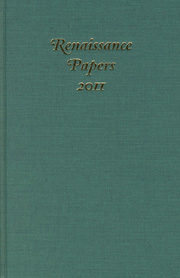Book contents
- Frontmatter
- Contents
- Dedication
- Walking, Waking, and the Armor of Light: Pauline Enactments in Henry IV, Part 1
- Costard's Revenge: Letters and Their Misdelivery in Love's Labour's Lost
- Productive Violence in Titus Andronicus
- Method in Marlowe's Massacre at Paris
- Ending Well: Mixed Genres and Audience Response in the London Theatrical Marketplace, 1604–06
- Birdlime: Sticky Entrapments in Renaissance Drama
- Sacrifice and Transcendence in Sir Philip Sidney's Astrophil and Stella
- The Quest for Certainty in Fulke Greville's A Treatie of Humane Learning
- Traces of the Masque in George Herbert's The Church
- Una Trinitas: Una and the Trinity in Book One of The Faerie Queene
- Reconsidering the 1599 Bishops' Ban on Satire
- Robert Bellarmine the Censor and Early-Modern Humanism
Costard's Revenge: Letters and Their Misdelivery in Love's Labour's Lost
Published online by Cambridge University Press: 05 April 2013
- Frontmatter
- Contents
- Dedication
- Walking, Waking, and the Armor of Light: Pauline Enactments in Henry IV, Part 1
- Costard's Revenge: Letters and Their Misdelivery in Love's Labour's Lost
- Productive Violence in Titus Andronicus
- Method in Marlowe's Massacre at Paris
- Ending Well: Mixed Genres and Audience Response in the London Theatrical Marketplace, 1604–06
- Birdlime: Sticky Entrapments in Renaissance Drama
- Sacrifice and Transcendence in Sir Philip Sidney's Astrophil and Stella
- The Quest for Certainty in Fulke Greville's A Treatie of Humane Learning
- Traces of the Masque in George Herbert's The Church
- Una Trinitas: Una and the Trinity in Book One of The Faerie Queene
- Reconsidering the 1599 Bishops' Ban on Satire
- Robert Bellarmine the Censor and Early-Modern Humanism
Summary
As many critics have noted, letters permeate Love's Labour's Lost at both the linguistic and structural levels. Patricia Parker has identified an extended pun on letters connected to the plot, and H. R. Woudhuysen has remarked that two thirds of the plays' scenes focus significantly on letters. Stanley Wells calls Biron's letter-exposure scene “a mid-play discovery that is quite as important in the design of this play as the Prince's discovery of Claudius's guilt is to the design of Hamlet.” However, while critics recognize the importance of epistles in the play, they overlook delivery conventions and remove bearers from the social practice of letter-delivery. Koshi Nakanori privileges content over the role of the bearer and the letters' superscriptions (the recipient's name and address written on the backside of a letter), calling Biron's and Armado's letters “interchangeable”: “If love letters and amatory talk are mere words after all, it does not matter from whom to whom they are addressed.” Thus, she ignores what Janet Altman has referred to in literature as “epistolarity,” “the use of the letter's formal properties to create meaning.” Critics who do discuss messengers in Shakespeare's plays—Costard in particular—deny their agency, calling them “utterly passive and neutral” and “generally disinterested.”
- Type
- Chapter
- Information
- Renaissance Papers 2011 , pp. 17 - 30Publisher: Boydell & BrewerPrint publication year: 2012



